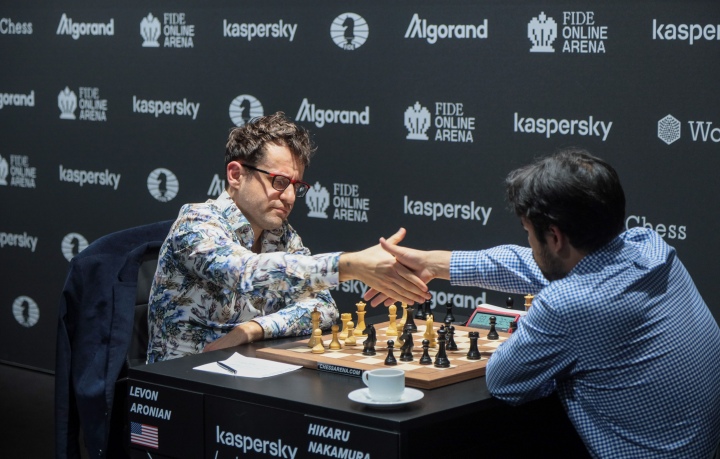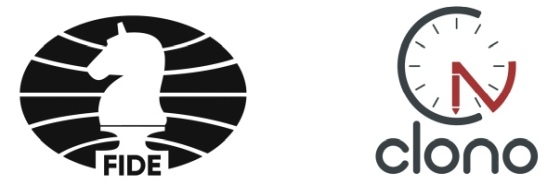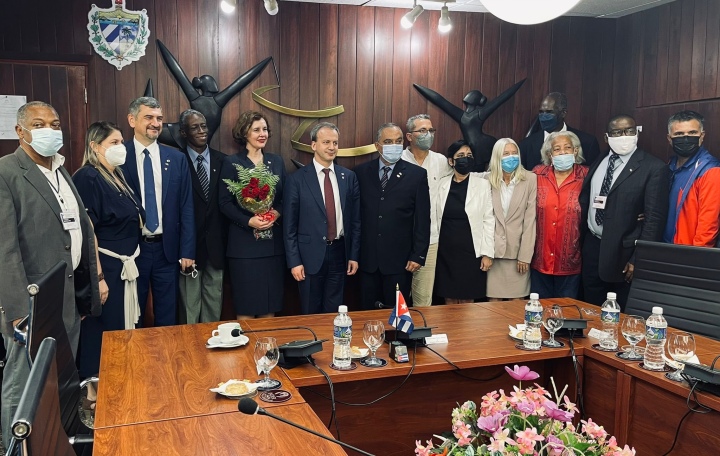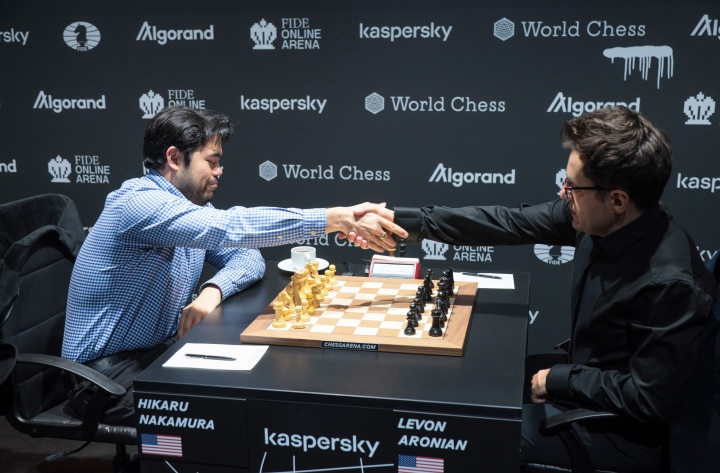FIDE Grand Prix: Aronian and Nakamura to battle it out in tiebreak

IM Michael Rahal – Berlin, February 16th – The second game of the final ended with a draw on move 29 by repetition, resulting in a tie in the classical part of the final. Therefore, both players will return tomorrow afternoon for the tiebreak: two 15/10 rapid games followed by two 3/2 blitz games. If the tie persists, a “sudden death” so-called Armageddon game will decide the winner of the FIDE Grand Prix Berlin, organized by World Chess. As usual, Hikaru Nakamura arrived with plenty of time to spare and was seated and concentrated several minutes before 3 pm. Not one to change his pre-game habits, Levon Aronian crossed the door exactly one minute before the start of the game, time enough for two quick security checks and the customary greeting with his opponent. Many players prefer not to arrive too early for the game to avoid being distracted with unnecessary chit-chat with officials or spectators, although they have never been disturbed. After a few introductory words by Chief Arbiter Ivan Syrovy, Aronian played his first move 1.e4. Nakamura quickly replied with 1…e5, and very soon, both players started to blitz out one of the latest trends in the popular Italian Opening: some of us actually caught our breaths for a moment, hoping to see 3.Bb5 and maybe the Berlin Wall, but it was not to be. The first eleven moves were played fast, but Aronian fell behind on the clock – for the first time in the tournament – when he spent over eight minutes on 12.a5, clamping down on the queenside. However, that was nothing compared to the thirty minutes that Nakamura pondered over 15…Qc7, to which Aronian immediately reacted with 16.d4. Nakamura was probably calculating and evaluating the pros and cons of the principled idea 15…d5, which the computer suggests as the best line for Black with complete equality. Nakamura’s move is also fine, but one wonders if the time spent could be needed for more critical positions later on. Things became very complicated when Nakamura conceded the center with 16…exd4 and then damaged his pawn structure terminally with 17…c5, leaving himself with a backward pawn on d6 and a gaping hole on the d5-square. However, Hikaru surely was counting on his piece activity as compensation. He has always been an aggressive player with an excellent feel for imbalances and active play. “It all hinges on whether this 16…exd4 17.Qxd4 c5 idea is OK Black or not OK,” said Nakamura in the postgame interview with IM Michael Rahal. “I thought that either I was completely fine or much worse, one of the two.” Nakamura took his time before capturing on b2. His reasoning was: ” I didn’t see a reason not to capture, so I should play the move. But I was assuming Aronian had some way to win material as he was allowing me to capture. As it turns out, it’s completely fine”. Aronian didn’t agree: “I thought I had a big advantage, but I completely blundered that Black could play 22…Qxb2. I thought that I had 23.Rb1 and 24. Rb3, completely forgetting that Black has 24…Qd4. After he captured on b2, I did consider Ba4 at some point, but I thought it wouldn’t work, so I went for the draw”. But Aronian did offer another option: “Instead of 22.Nd2, I should have played 22.Ra2 and my position is very pleasant, just a slight plus, I am pressing”. You can watch a postgame interview with both players on the World Chess Youtube channel Text: IM Michael Rahal Photo: Official Photo FIDE Grand Prix Berlin Press Kit About the Tournament The three-tournament Grand Prix series, which will unfold from February to April, features twenty-four of the world’s best Grandmasters, who will compete in two of the three events. In order to make the series more exciting and reduce the percentage of draws, FIDE and World Chess have changed the format. This innovative approach is new for the chess world but very similar to the Super League: the first stage has four pools of four players, and the winner of each pool advances to the semifinals and then to the final. The venue of the first leg is the World Chess Club Berlin, located at the City Centre on Unter den Linden, 26-30, and the games will be played from February 4th-17th every afternoon at 3 pm. Along with the two qualification spots for the Candidates, the event has a €150,000 euros prize fund, €20,000 more than the 2019 series. All the games will be broadcasted live with expert commentary in three languages at https://chessarena.com/broadcasts/13604 More information and the full schedule can also be found on the worldchess.com website. Full pairings can be found here. Due to COVID restrictions currently in place, only a limited number of tickets are available. Please note that the 2G+ rule applies to the event, which means that visiting the venue is only possible for those who either have a complete vaccination with EU-certified vaccine or proof of recovery and can additionally present a booster dose certificate or a negative test result. The FIDE Grand Prix Series is brought to you by World Chess. Leading companies supporting the FIDE Grand Prix Series 2022 include: Kaspersky as the Official Cybersecurity PartnerAlgorand as the Official Blockchain PartnerPrytek as the Technology Transfer PartnerFIDE Online Arena as the official Partner For further questions, please contact: media@worldchess.com
Jennifer Shahade: “’Being good at chess’ is also how well you use it to enhance your life”

The second episode of the FIDE Podcast, the initiative born under the umbrella of the Year of the Woman in Chess, as cooperation between FIDE’s Commission for Women’s Chess, Michael Busse of Schachgeflüster podcast, and Lilli Hahn of Chess Sports Association, has just been released. The podcast’s monthly episodes feature a series of interviews with remarkable women in the chess world. The guest of Episode 2 is Jennifer Shahade, a two-time the United States Women Chess Champion, commentator and writer, whose new book “Chess Queens: The True Story of a Chess Champion and the Greatest Female Players of All Time” will be published next month. Through her own story and in-depth profiles of the top female players, Jennifer invites us into the extremely competitive and male-dominated world of chess. “The one thing which I feel really strongly about, which I think comes through in all my work, is that what we need more of in chess is positivity towards women. So there is a lot of negative stuff. But if all we do is talk about the negative stuff, it’s not really fair to the women who are out there kicking butt. Right?” says Jennifer in her interview. “I think that being positive is not just some buzzword. It’s an imperative if we want to push women forward in the game.” You can listen the second episode of the FIDE podcast on the following platforms: Podbean Amazon Music Spotify Google Podcasts
FIDE introduces the use of electronic scoresheets in cooperation with Clono

The International Chess Federation has approved allowing the use of Clono electronic scoresheet to record the moves of the games at official chess competitions, in replacement of traditional, paper-based scoresheets. The Clono scoresheet app runs on a tablet, and the input is done on a graphical chess board where the scoresheet is presented in standard algebraic format. The system offers smooth integration with other existing tools. For instance, it can automatically create a tournament profile with tournament info, time control, groups and players, simply importing the tournament xml-file directly from the tournament management service. It can receive the player’s and game info, pushed directly from the pairing program. Likewise, Clono can send the PGN live feed to its own broadcast server and multigame viewer, as well as to third party websites. FIDE and Clono have agreed to cooperate for the purposes of developing and digitalizing chess in the work frame of the Chess-ID project. For the time being, the agreement has a non-commercial nature, and the aim is to lower the threshold for the chess community to use the new system.
FIDE delegation makes tour of Latin America

The FIDE delegation, headed by President Arkady Dvorkovich, including managing director Dana Reizniece-Ozola and executive director Victor Bologan, travelled to Cuba, Panama, Ecuador, and Mexico to strengthen ties between FIDE and sports institutions in the region and promote chess in Latin America. The first stop on tour was Cuba. In Havana, FIDE representatives met the President of the Cuban National Institute of Sports, Physical Education and Recreation (INDER) Osvaldo Vento Montiller, the Cuban Olympic Committee President Roberto Léon Richards Aguiar, and the President of the Cuban Chess Federation Carlos Rivero. Among the issues discussed was the inclusion of chess in the regional games and the long-established tradition of Cuban chess. During the visit, the main focus was on the social aspect of chess. The delegation visited the “Grandparents’ House”, where chess is an important tool for promoting “active ageing”. The FIDE representatives were also briefed about the other social activities in the country. “Caissa XXI” project involves 12 chess masters and grandmasters who reach out to slums and train approximately 800 children a month. This great initiative gives children from low-income families motivation and skills to climb the social ladder. “This is a country where they not only love chess but smartly use it for the benefit of society. Such initiatives like Chess in Slums, Сhess in Prisons, Chess for Seniors allow using our game for education&empowerment. Amazing!” Dana Reizniece-Ozola said. Cuba has taken huge steps in introducing chess in schools. Kids have chess lessons twice a week, and also research on chess influencing cognitive skills has been conducted. FIDE will support the 55th Capablanca Memorial, and as part of the Year of the Woman in Chess, a women’s tournament will be organized in Cuba. “We are happy to be here. We have many ideas for joint projects, and we have come to learn from Cuba how they do things with chess to achieve the results they have,” said FIDE President Arkady Dvorkovich, summing up his two-day stay in the country. Panama was the second stop in the round of visits. Upon arrival in the country, the FIDE delegation was received by the First Lady of Panama Yazmín Colón de Cortizo. The First Lady was particularly interested in teaching chess as a ‘vehicle’ for introducing other subjects: language, mathematics and STEM. The second meeting was to Damaris Young, a former basketball player, lawyer, and the first woman president of the Olympic Committee of Panama. She made a presentation in which she emphasized the competitive side of sports and its value as a tool of inclusion. FIDE would like to thank the Panamanian Chess Federation (FAP) and its President Jose Carrillo Pujol for their hospitality and the productive meetings that they scheduled during the visit. After Panama, the FIDE delegation flew to Guayaquil, Ecuador, invited by FIDE Vice-President Martha Fierro to take part in the opening ceremony of “Chess in your neighbourhood”. The project, co-financed by the FIDE Development Fund through FIDE Americas, also enjoys extensive public and private support in Ecuador. Marcos Molina, President of the Health and Sport Commission of the National Assembly, stressed that this initiative aims “to liberate the hearts of these children, and targets the most vulnerable classes, classes that deserve greater attention from the E status”. The FIDE delegation also had the opportunity to meet with the President of the Republic of Ecuador, Guillermo Lasso. During the visit to Mexico, the FIDE management had a working meeting with María José Alcalá Izguerra, the President of the Mexican Olympic Committee (COM). After the meeting, they cut the ribbon for the new “Center for Chess Development”. “It is a place that will allow chess to be promoted and at the same time create the conditions for training and improving in chess from a very young age,” said Alcalá Izguerra. In addition, a continental FIDE Planning and Development Commission’s meeting was organized, using the opportunity of continental representatives getting together at the 8th Ibero American Individual Chess Championship. The delegates from 28 countries who arrived at the meeting were given a warm welcome by Mario Ramirez Barajas, the President of the Mexican Chess Federation.
Exciting chess in the FIDE Grand Prix Berlin final

The first game between Nakamura and Aronian ends in a draw IM Michael Rahal – Berlin, February 15th 2022 – Levon Aronian and Hikaru Nakamura have definitely been the strongest players in this event, and they are clearly well-deserved finalists. Their first game today was one of the most exciting games of the tournament, but it’s not the first time they have faced each other. According to the database, Aronian and Nakamura have played on 188 occasions, with a 103½ – 84½ score for Nakamura. However, most of these encounters were blitz and rapid, many of them in online events. In classical chess, they have battled it out 45 times, the first time in the 2005 Gibraltar Masters: Aronian has a huge 27-18 point advantage in these official games. The first player to appear today at the venue was Hikaru Nakamura. An early starter, Hikaru has normally been arriving about ten minutes before the start of the game. His ritual is basically the same: prepare a coffee and two or three bottles of still water – he always checks the bottle cap carefully: pink for still water and blue for gas water. He also picked up a couple of chocolate bars today – an energy boost might always come in handy. All players are body-checked with security wand metal detectors twice before the game: the first time as soon as they enter the venue and the second time after they have taken off their jackets and other belongings. Contrarily, Levon Aronian is usually the last player to arrive and goes straight to the board. He generally stops by the arbiter’s table to clean his hands with hydrological gel and then greets his opponent, takes off his blazer and gets ready for the game. The fair play officer in charge of these security checks is GM Alex Colovic from Macedonia. He was kind enough to explain to us the nuances behind his job. Nakamura opened the game with 1.e4, and Aronian chose 1…e5, his main defensive weapon for many years. The opening was a classical Ruy Lopez: Levon wanted to play the Marshall Attack, a very aggressive option for Black but which nowadays seems to end in a draw every time it’s played in an elite game. “I am always happy just to play chess, I don’t really care what opening it is, it’s a great privilege. I think it was interesting, I got a nice position after Hikaru made this erroneous plan with Nh2-Ng4” were Aronian’s first impressions in the post-game conference, in conversation with IM Michael Rahal, FIDE press officer for the event. Hikaru chose 8.h3, one of the many anti-Marshall systems, which was actually Ian Nepomniachtch’s choice against Magnus Carlsen in their 2021 Dubai World Championship match. Aronian also has vast experience in this line, both with White and with Black: he actually played it six times against Ding Liren two months ago in the Chess.com Speed Chess Blitz online event. When asked after the game if the Marshall was a good opening choice for Black, Nakamura was very clear: “Everything is sound with the computers these days; it doesn’t even matter what you play. I wanted to play something slow today”. Although 9…d5, in gambit style, is still a theoretical option, Aronian decided to play it safe with 9…d6. Nakamura introduced a novelty 12.Nh2 instead of playing in the center with 12.d4, a move that has been seen in more than fifty grandmaster games. Unfazed, Aronian completed the standard manoeuvre 12…Nd8-e6 followed by 15…Ra-e8 keeping his options totally open while at the same time prophylactically preventing all of White’s pawn breaks. Things were looking good for Black. Nakamura spent a lot of time around moves 15-20: the feeling in the press room was that maybe he was uncomfortable with the position. Aronian’s opening preparation has been excellent in this event, and he has played these types of structures many times before: he is one of the world’s leading experts in Ruy Lopez middlegame positions. The key moment of the game happened on move twenty-two. Nakamura went for 22.Bh6, attacking his opponent’s rook but apparently sacrificing his pawn on d3. Aronian had obviously calculated this beforehand and quickly captured the pawn with his knight. The online commentators expected Nakamura to play 23.Rd1 and win the exchange, but Hikaru smelled a rat and started thinking. Nakamura thought he was clearly still in the game: “It became very complicated. I am down a pawn, but I have this outside pawn on a5 and this pawn on b4, and it gets very tricky because the pawns on the side are more important than the pawns in the center. I was already quite confused because I thought that Levon was much better”. After a while, he opted to exchange rooks and continue the game a pawn down. He did have some positional compensation, although it was clear that Black was better: the question was how much? Commentating online for World Chess, GM Evgenij Miroshnichenko affirmed: “If Aronian wins today, it practically means the end of the match. Hikaru really has to be very careful not to lose. It’s understandable; he wants to try his chance with White, at least to apply some pressure, but somehow losing seems easier than winning”. After the game, the players discussed for a few minutes several options. In the press conference, Nakamura mentioned that “There was a critical moment in the game when Levon played 25…Qa8 where instead he could have played 25…Qb8. The whole evaluation of the position hinges on that one position. When I got my rook to b1, I was already quite optimistic”. It’s always difficult to say, but maybe Aronian could have included 27…a5. Slowly but surely, Aronian’s advantage slipped away. Although he was low on time, Nakamura began to play the best moves, and the game was heading towards a draw, according to computer analysis. However, it was very tricky: any bad move could immediately be fatal. “I think that I was too optimistic,” said

